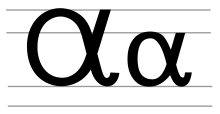Latin alpha


Latin alpha (majuscule: Ɑ, minuscule: ɑ) or script a is a letter of the Latin alphabet based on one lowercase form of a, or on the Greek lowercase alpha (α).
Usage[]
Although ⟨ɑ⟩ is normally just an allograph of ⟨a⟩, there are instances in which the two letters must be carefully distinguished:
- In the International Phonetic Alphabet, ⟨ɑ⟩ represents an open back unrounded vowel, while ⟨a⟩ represents an open front unrounded vowel. It has the shape of a script-a.
- Also in the General Alphabet of Cameroon Languages, ⟨Ɑ ɑ⟩ usually represents an open back unrounded vowel, while ⟨A a⟩ represents an open front unrounded vowel. The former is used in the orthographies of several languages of Cameroon, including:
- Fe'fe'[1][2]
- Mbembe[3]
- Mbo (?): but not Akoose, though it does have phonemes /aa/ and /ɑɑ/;[4] nor Bakaka.[5]
- in some languages, the script-a form (also called literacy form) of the letter ⟨A a⟩, with the lowercase much like the IPA ⟨ɑ⟩, is used and should not be confused with the Latin alpha ⟨Ɑ ɑ⟩ of the GACL; for example, in Muyang, the literacy ⟨A a⟩ represents an open-mid central unrounded vowel but it is not ⟨Ɑ ɑ⟩; the Latin alpha is not used.[6]
In Cameroon languages, ⟨Ɑ ɑ⟩ must look like the classical lowercase Greek alpha to better differentiate it from the letter a in script form.
U+1D45 ᵅ MODIFIER LETTER SMALL ALPHA is used in the Uralic Phonetic Alphabet.[7]
U+AB30 ꬰ LATIN SMALL LETTER BARRED ALPHA is used in the Teuthonista phonetic transcription system.[8]
U+AB64 ꭤ LATIN SMALL LETTER INVERTED ALPHA is used in Americanist phonetic notation.[9]
Typography[]

Encoding and forms[]
In Unicode, "Latin alpha" (![]()
![]() ) and "Latin script a" (
) and "Latin script a" (![]()
![]() ) are considered to be the same character, which has an uppercase and a lowercase form and is referred to as "Latin letter alpha".
) are considered to be the same character, which has an uppercase and a lowercase form and is referred to as "Latin letter alpha".
| Preview | Ɑ | ɑ | ||
|---|---|---|---|---|
| Unicode name | LATIN CAPITAL LETTER ALPHA | LATIN SMALL LETTER ALPHA | ||
| Encodings | decimal | hex | decimal | hex |
| Unicode | 11373 | U+2C6D | 593 | U+0251 |
| UTF-8 | 226 177 173 | E2 B1 AD | 201 145 | C9 91 |
| Numeric character reference | Ɑ |
Ɑ |
ɑ |
ɑ |
See also[]
- Turned a discusses the turned Latin alpha
- G, which also has two distinct minuscule forms
References[]
- ^ Priest, Lorna A.; Constable, Peter G. (2005). "Proposal to Encode Additional Latin Phonetic and Orthographic Characters" (PDF). Retrieved March 17, 2013.
- ^ "L'alphabet camerounais leçon 1.2" (in French). Retrieved March 17, 2013.
- ^ EYOH, Julius A.; Echebi Emmanuel SANDAMU (2009). "Mbembe Orthography Guide". Retrieved March 17, 2013.
- ^ HEDINGER, Robert (2011). "Akoose". Retrieved March 17, 2013.
Among the short vowels the two a-sounds and the two o-sounds are in complementary distribution and therefore do not have to be distinguished in the orthography. However, there is a problem in the long vowels where the two pairs of sounds distinguish between distinct words. Up to now they have not been distinguished and it seems this doesn’t cause any problem to readers.
- ^ SPIELMANN, Kent (1998). "Mkaa' Orthography Review (Bakaka)". Retrieved March 17, 2013.
- ^ SMITH, Tony (2001). "Alphabet et orthographe Muyang" (in French). Retrieved March 17, 2013.
- ^ Everson, Michael; et al. (2002-03-20). "L2/02-141: Uralic Phonetic Alphabet characters for the UCS" (PDF).
- ^ Everson, Michael; Dicklberger, Alois; Pentzlin, Karl; Wandl-Vogt, Eveline (2011-06-02). "L2/11-202: Revised proposal to encode "Teuthonista" phonetic characters in the UCS" (PDF).
- ^ Schneidemesser, Luanne von; et al. (2012-07-31). "L2/12-266: Proposal for Two Phonetic Characters" (PDF).
- Latin-script letters
- Phonetic transcription symbols
- Vowel letters
- Latin script stubs
- Phonetics stubs